|
|
 |
Fiche d'espèce de Copépode |
|
|
Calanoida ( Ordre ) |
|
|
|
Calanoidea ( Superfamille ) |
|
|
|
Calanidae ( Famille ) |
|
|
|
Calanus ( Genre ) |
|
|
| |
Calanus australis Brodsky, 1959 (F,M) | |
| | | | | | | Syn.: | Calanus finmarchicus : Farran, 1929 (part., p.207, 212: Pacific forms); Dakin & Colefax, 1933 (p.203); 1940 (p.87, figs.F,M); ? Oliveira, 1945 (p.191); Kott, 1957 (p.5, Rem.: p.14); Vervoort, 1957 (part., p.24, figs.F, Rem.: p.25).
? Calanus helgolandicus : Ong & Lake, 1969 (p.9, ultrstructure of migut; from 43°15'S, 147°15'E);
Calanoides australis : Huntley & Lopez, 1992 (p.201, Table A1, egg-adult weight, temperature-dependent production); | | | | Ref.: | | | Brodsky, 1959 a (p.1539, figs.F,M, Rem.: 2 or 3 var.); 1961 (p.7, 17, figs.F,M); Deevey, 1966 (p.161); Grice & Hulsemann, 1967 (p.13, 20: fig.F, Rem.); Vidal, 1968 (p.13, figs.F,M); Kun, 1969 (p.996, 997, figs.F); Ramirez, 1969 (p.34, figs.F,M, Rem.); Jillett, 1971 (p.29, Rem.); Heinrich, 1971 (p.292, Rem.); Brodsky, 1972 (1975) (p.9, 66, 82, 119, figs.F,M); Bradford, 1972 (p.31, figs.F,M); Bradford & Jillett, 1974 (p.6); Arcos, 1975 (p.7, figs.F); Vyshkvartzeva, 1977 a (p.97, figs.F); Björnberg & al., 1981 (p.618, fig.); van der Spoel & Heyman, 1983 (p.62, fig.79); De Decker, 1984 (p.320, Rem.); Bradford, 1988 (p.74, 76, Rem.); Bradford & al., 1988 (p.301, Developpt., figs.N, juv.); Nishida, 1989 (p.173, table 2, 3, dorsal hump); Marin & al., 1994 (p.75, Rem.M); Bradford-Grieve, 1994 (p.31, figs.F,M, Rem., fig.98); Mazzocchi & al., 1995 (p.95, figs.F,M, Rem.); Bradford-Grieve & al., 1999 (p.877, 907, figs.F,M); Ramirez & Sabatini, 2000 (p.24, figs.F,M); Hill & al., 2001 (p.279, fig.2: phylogeny); Ferrari & Dahms, 2007 (p.36, Rem. N); |  issued from : J.M. Bradford-Grieve in The Marine Fauna of New Zealand: Pelagic Calanoid Copepoda. National Institute of Water and Atmospheric Research (NIWA). New Zealand Oceanographic Institute Memoir, 102, 1994. [p.24, Fig.6]. Female: A, habitus (dorsal); B, idem (right lateral side); C, A1; D, A2; E, Md; F, detail of cutting edge of mandibular blade; G, Mx1; H, Mx2; I, Mxp.
|
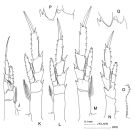 issued from : J.M. Bradford-Grieve in The Marine Fauna of New Zealand: Pelagic Calanoid Copepoda. National Institute of Water and Atmospheric Research (NIWA). New Zealand Oceanographic Institute Memoir, 102, 1994. [p.25, Fig.6 ((overleaf). Female: J, P1; K, P2; L, P3; M, P4; N, P5; O, inner edge of basipod 2 of P5; P, disto-anterior border of basipod 2 of P4 (anterior ); Q, disto-anterior border of basipod 2 of P5 (anterior).
|
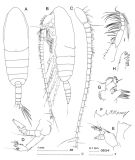 issued from : J.M. Bradford-Grieve in The Marine Fauna of New Zealand: Pelagic Calanoid Copepoda. National Institute of Water and Atmospheric Research (NIWA). New Zealand Oceanographic Institute Memoir, 102, 1994. [p.26, Fig.7]. Male: A, habitus (dorsal); B, idem (left lateral side); C, A1; D, A2; E, Md; F, Md (masticatory edge); G, Mx1; H, Mx2; I, Mxp.
|
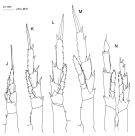 issued from : J.M. Bradford-Grieve in The Marine Fauna of New Zealand: Pelagic Calanoid Copepoda. National Institute of Water and Atmospheric Research (NIWA). New Zealand Oceanographic Institute Memoir, 102, 1994. [p.27, Fig.7 (overleaf). Male: J, P1; K, P2; L, P3; M, P4; N, P5.
|
 Issued from: M.G. Mazzocchi, G. Zagami, A. Ianora, L. Guglielmo & J. Hure in Atlas of Marine Zooplankton Straits of Magellan. Copepods. L. Guglielmo & A. Ianora (Eds.), 1995. [p.96, Fig.3.13.1]. Female: A, habitus (lateral right side); B, urosome (lateral right side); C, P5; D, basipod 1 and 2 of P5. Nota: Proportional lengths of urosomites and furca 36:19:13:16:16 = 100. Basipods 1 of P5 ornated with 14-20 slightly curved, triangular teeth (number of teeth along margins of left and right rarely the same). Male: E, urosome (dorsal); F, P5. Nota: Proportional lengths of urosomites and furca 12:30:17:12:11:18 = 100. basipod 1 of P5 with asymmetrical left and right sides, ornated with 12-18 teeth.
|
 Issued from: M.G. Mazzocchi, G. Zagami, A. Ianora, L. Guglielmo & J. Hure in Atlas of Marine Zooplankton Straits of Magellan. Copepods. L. Guglielmo & A. Ianora (Eds.), 1995. [p.97, Fig.3.13.2]. Female (SEM preparation): A, habitus (dorsal); B, idem (lateral left side); C, rounded left postero-lateral corner of last thoracic somite; D, P5; E, detail of basipod 1 of P5. bars: A, B 0.500 mm; C, D 0.100 mm; E 0.010 mm.
|
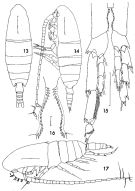 issued from : F.C. Ramirez in Contr. Inst. Biol. mar., Buenos Aires, 1969, 98. [p.32, Lam. III, figs.13-17 ]. Female (from off Mar del Plata): 13, habitus (dorsal); 14, idem (lateral left side; 16, intrior margin of basidodal segment 1 of P5). Nota: Serrate inner edge of coxa of P5 lyre-like, with 18-22 small triangular teeth Male: 15, P5; 17, habitus (lateral left side). Nota: Inner margin of coxa serrated (15-19 teeth). Right exopod of P5 reaching 1/3 of the length of the left exopod segment 2. Scale bars in mm: 0.5 (13, 14, 17); 0.2 (15); 0.025 (16).
|
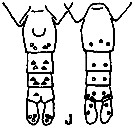 issued from K. Hulsemann in Invert. Taxon., 1994, 8. [p.1477, Fig.28, J]. Female: J, urosome (left: ventral); right: dorsal). Pore signature schematic by pooled samples (symbols are considerably larger than pores): Filled circle: 100 % presence; open circle: 95-99 % presence; triangle: 50-89 % presence. n = 40.
|
 issued from : W. Vervoort in B.A.N.Z. Antarct. Res. Exped., Rep.-Ser. B, III, 1957. [Fig.1]. As Calanus finmarchicus. Female (from 44°05'S, 147°35' E): a-b, habitus (lateral and dorsal, respectively); c, P5 (left leg partly figured); d, basal portion of P5 (posterior surface).
|
 issued from : W. Vervoort in B.A.N.Z. Antarct. Res. Exped., Rep.-Ser. B, III, 1957. [Fig.2]. As Calanus finmarchicus. Female: a-b, posterior part of cephalothorax and urosome (dorsal and lateral, respectively).
|
 issued from : J.M. Bradford in Mem. N. Z. Oceonogr. Inst., 1972, 54. [p.33, Fig.4 (1-3)]. Female (from Kaikoura, New Zealand): 2, habitus (lateral); 3, P5 (basipod segment 1). Male: 1, left P5. Scale bars: 1 mm (2); 0.1 mm (1, 3).
|
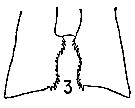 issued from : G.D. Grice & K. Hulsemann in Proc. U. S. natn.Mus., 1967, 122 (3583). [p.47, Fig.3]. Female (from S Indian Ocean: 35)09'S, 69°59'E): 3, basipodal segment 1 of P5. Nota: In dorsal view the slightly produced anterior end of the head and the narrow 5th thoracic segment make the specimen referable to Brodsky's C. autralis var. atlanticus. This is the first record of this species from the Indian Ocean.
|
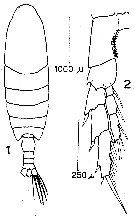 issued from : D.F.R. Arcos in Gayana, Zool., 1975, 32. [Lam.I, Figs.1-2]. Female (from Bahia de Concepcion, Chile): 1, habitus (dorsal); 2, P5.
|
 issued from : K.A. Brodsky in Zool. Zh., 1959, 38, 10. [p.1541, Fig.3, 11, 13, 14]. Comparison of coxopodite inner edge of P5 female for Calanus australis var. pacificus (11) (from Chile), C. australis var. pacificus (13) and C. australis var. atlanticus (14). General remarks: Dentate plate on coxopodite of P5 has teeth with sharp tips, triangular in shape and not spaced. Teeth on distal part of segment particularly large. Number of teeth varied from 15-22, being most frequently 15-19. Curve of teeth-line weakly marked but form of inner edges (dentate) lyre-shaped. Distal segment of endopodites with 5 bristles. Relation of breadth to length of prosome 1 : 3 to 1 : 3.1. last thoracic segment has rear angles drawn together, they embrace, as it were, the proximal third of the genital segment. Genital segment when viewed laterally does not have parallel dorsal and ventral sides but has double peak on the ventral side (on ventral projection), reniform in shape. A1 longer than body by 2-3 segments. C. australis var. pacificus (from 48°12'S, 174°30'E): Body shape, as compared with individuals from Tasmanian population, is distinguished by being more elliptical, in lateral view no protuberance is nonoticeable on the forehead. Dentate plate of coxopodite of P5 with anumber of teeth = 22. Sistal teeth womewhat larger than proximal. Calanus australis var. pacificus ( (from 45°04'S, 75°33'W): No differences found between this and typical form from New Zealand waters. Dentate plate of coxopodite of P5 with 15, 19 and 22 teeth. In Fig.3- 11 greater size of distal teeth is clearly visible. Calanus australis var. atlanticus (from 37°49'S, 56°35'W): Body shape more slender than in specimens from New Zealand waters; last thoracic segment is womewhat narrower. Coxopodite dentate plate of P5 with 19-20 teeth.
|
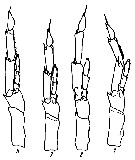 issued from : K.A. Brodsky in Zool. Zh., 1959, 38, 10. [p.1542, Fig.4, 6-9]. Comparison of left leg of P5 for Calanus australis var. pacificus (6), C. australis var. pacificus (New Zeland) (7) (from off Chile), C. australis var. C. atlanticus (8) (Argentina), and C. australis var. atlanticus (9) (Argentina). General remarks: Left endopodite longer than 1st segment of exopodite of same leg, reaching 1/6 - 1/4 of length of 2nd segment of exopodite. Exopodite of relatively thin and long segments. Dentate plate of coxopodite of P5 with sharp, triangular teeth, slightly curved in distal part. Number of teeth not high: 14-15. Last segment of endopodite of P5 has 6 bristles. C. australis var. pacificus (from 48°12'S, 174°30'E): Relation of breadth to length of 1st segment of exopodite of left P5: 1 : 3.2. Calanus australis var. pacificus ( (from 45°04'S, 75°33'W): P5 also of typical structure, but endopodite of left leg is relatively somewhat longer (Fig.4-7), and 2nd segment of exopodite of left leg is somewhat shorter: relation of breadth to length of this segment 1 : 3.1, of 1st segment 1 : 3.2. Calanus australis var. atlanticus (from 37°49'S, 56°35'W): Relation of breadth to length of 1st and 2nd segments of exopodite of left P5: 1.-3.5 and 1 : 3.1.
| | | | | Ref. compl.: | | | Deevey, 1966 (p.155, Table 3, lengths variation), Heinrich, 1973 (p.95, fig.4); Björnberg, 1973 (p.284, 384, carte); Heinrich, 1974 (fig.3); Arcos, 1976 (p.85, Rem.: p.89, Table II); Arashkevich, 1978 (p.118, Table: diets); Nyan Taw & Ritz, 1979 (p.190); Arashkevich & al., 1982 (p.477, Table 2, diet); Kimmerer & McKinnon, 1985 (p.149, Table1, abundance); Ohman, 1987, p.1317, Table 1: ingestion); James & Wilkinson, 1988 (p.249, Table 1, 2, biomass, carbon ingestion); Afanas'yev & al., 1989 (p.225, genetic); Attwood & Peterson, 1989 (p.121, fecundity, lipid); Peterson & Painting, 1990 (p.283, development rate); Fernandez Araoz, 1991 (p.575); Flint & al., 1991 (p.199); Santos & Ramirez, 1991 (p.79, 80, 82); 1995 (p.133, Tabl. I, fig.2, 3); Klein Breteler & al., 1994 (p.1039, fig. 5, 6, 8, Rem.: p.1053, stage duration); Stephen, 1998 (p.342, 343, Rem.); Barange & al., 1998 (p.1663, Table 2, 5, abundance vs STC region); Razouls & al., 2000 (p.343, Appendix); Sabatini & al., 2000 (p.1856, Distribution vs. hydrology); Pakhomov & al., 2000 (p.1663, Table 2, transect Cape Town-SANAE antarctic base); Sabatini & al., 2001 (p.245, figs.6, 7, 9); Marrari & al., 2004 (p.667, tab.1) (p.1856); Berasategui & al., 2005 (p.313, fig.2); Ayon & al., 2008 (p.238, Table 4: Peruvian samples); Sabatini, 2008 (p.981, life history); Park & Ferrari, 2009 (p.143, Table 2, fig.2, Appendix 1, biogeography); C.E. Morales & al., 2010 (p.158, Table 1, 2); Antacli & al., 2010 (p.71, Table 1, 2, Fig.2); Aguirre & al., 2012 (p.341, Table I: abundance vs season); Hidalgo & al., 2012 (p.134, Table 2); Peijnenburg & Goetze, 2013 (p.2765, table 1, genetic data); Fierro Gonzalvez, 2014 (p.1, Tab. 3, 5, occurrence, abundance); Antacli & al., 2014 (p.17, occurrence vs community structure); Antacli & al., 2018 (p.295, feeding, reproduction); Record & al., 2018 (p.2238, Table 1: diapause); Acha & al., 2020 (p.1, Table 3: occurrence % vs ecoregions, Table 5: indicator ecoregions). | | | | NZ: | 6 | | |
|
Carte de distribution de Calanus australis par zones géographiques
|
| | | | | | | | |  issued from : F.C. Ramirez & M.E. Sabatini in Hydrobiologia, 2000, 439. [p.32, Fig.8]. issued from : F.C. Ramirez & M.E. Sabatini in Hydrobiologia, 2000, 439. [p.32, Fig.8].
Seasonal relative abundance and distribution of adults in water off Argentina. |
 Issued from : M.E. Sabatini, F.C. Ramirez & P. Martos in ICES J. Mar. Sci., 2000, 57 (6). [p.1860, Fig.5]. Issued from : M.E. Sabatini, F.C. Ramirez & P. Martos in ICES J. Mar. Sci., 2000, 57 (6). [p.1860, Fig.5].
Stratification of the water column (isohalines of stability) and depth-integrated population abundance of calanus australis in the study area.
Station numbers correspond to zooplankton sampling and crosses to CTD stations.
Nota: Samples (n = 44) collected from 10 to 22 March 1998, using a multiple openinf-g/closing multinet (150 µm mesh size). Sampling by horizontal tows at each of 3-4 discrete depths covering the total water column in ca. 25-m steps.
Differences in population densities were related to geographical difference in water column stability. |
 Issued from : E.T. Park & F.D. Ferrari in A selection from Smithsonian at the Poles Contributions to International Polar year. I. Krupnik, M.A. Lang and S.E. Miller, eds., Publs. by Smithsonian Institution Scholarly Press, Washington DC., 2009. [p.167, Fig.2.] Issued from : E.T. Park & F.D. Ferrari in A selection from Smithsonian at the Poles Contributions to International Polar year. I. Krupnik, M.A. Lang and S.E. Miller, eds., Publs. by Smithsonian Institution Scholarly Press, Washington DC., 2009. [p.167, Fig.2.]
Distribution of selected pelagic calanoids Calanus australis of the Southern Ocean and the closest relative in the subarctic region of the Arctic Ocean. |
 Issued from : W.C.M. Klein Breteler, N. Schogt & J. van der Meer in J. Plankton Res., 1994, 16 (8). [p.1051, Fig. 8]. Issued from : W.C.M. Klein Breteler, N. Schogt & J. van der Meer in J. Plankton Res., 1994, 16 (8). [p.1051, Fig. 8].
Stage duration (days) of C. australis at 15°C and excess of food. Data from Peterson & Painting (1990): original result using a linear distribution function after data selection (*), present result by fitting a gamma distribution function (o); bars indicate two times the asymptotic standard error, calculated from N III onwards.
Nauplii: stages 1-6, copepodites 1-5 (7-11). |
| | | | Loc: | | | sub-Antarct. (SW Atlant., SW & SE Pacif., Beagle Channel), S South Africa (Southern Benguela & Agulhas Bank), Magallanes region, Patagonian Shelf, Peninsula, Valdés, off Mar del Plata, Tristan da Cunha, S Indian, New Zealand (Cape Farewell-South Taranaki Bight, Kaikoura), S Australia, Melbourne, Tasmania, Pacif. (SE tropical), S Pacif. (NPFZ), off Peruvian coast, Chile (., off Santiago, Concepcion), Strait of Magellan | | | | N: | 57 | | | | Lg.: | | | (25) F: 3,11-2,71; (36) F: 3,04-2,47; M: 2,78; (116) F: 3,5-2,4; M: 3,35-2,42; (187) F: 3,17-2,94; M: 2,88-2,58; (196) F: 3,59-2,5; M: 3,47-2,9; (339) F: 3,4-2,5; M: 3,3-2,7; (818) F: 3,53-3,03; M: 3,57-3,07; (849) F: 3,03-3,53; M: 3,07-3,57; (861) F: 3,69-3,76; (1125) F: 3,0-3,1; {F: 2,40-3,76; M: 2,42-3,57}
The mean female size is 3.080 mm (n = 18; SD = 0.4379), and the mean male size is 3.002 mm (n = 11; SD = 0.3793). The size ratio (male : female) is 0.993 (n = 6; SD = 0.0530). | | | | Rem.: | épi-bathypélagique.
Sampling depth (sub-Antarct.) : 0-1000 m.
After Arashkevich (1978) the diets of the species are centric and pennate diatoms (mainly in the gut content), flagellates, radiolarians, foraminifera, tintinnids, silicoflagellates, coccolithophorids and shapeless mass (less frequent).
Calanus australis atlanticus Brodsky,1959 (F,M)
Ref.: Brodsky, 1959 a (p.1546, figs.F,M); 1961 (p.18, figs.F,M); Grice & Hulsemann, 1967 (p.20)
Loc.: off Argentine
Lg.: (339) F: 3-2,7; M: 3,1-2,7
Calanus australis pacificus (F,M) Brodsky,1959 (F,M)
Ref.: Brodsky, 1959 a (p.1546, figs.F,M); 1961 (p.17, figs.F,M)
Lg.: (339) F: 3,4-2,5; M: 3,3-2,8 (N-Z); F: 3,4-2,5; M: 3,3-3,1 (off Chili)
Voir aussi les remarques en anglais | | | Dernière mise à jour : 03/12/2020 | |
|
|
 Toute utilisation de ce site pour une publication sera mentionnée avec la référence suivante : Toute utilisation de ce site pour une publication sera mentionnée avec la référence suivante :
Razouls C., Desreumaux N., Kouwenberg J. et de Bovée F., 2005-2025. - Biodiversité des Copépodes planctoniques marins (morphologie, répartition géographique et données biologiques). Sorbonne Université, CNRS. Disponible sur http://copepodes.obs-banyuls.fr [Accédé le 01 janvier 2026] © copyright 2005-2025 Sorbonne Université, CNRS
|
|
 |
 |





















